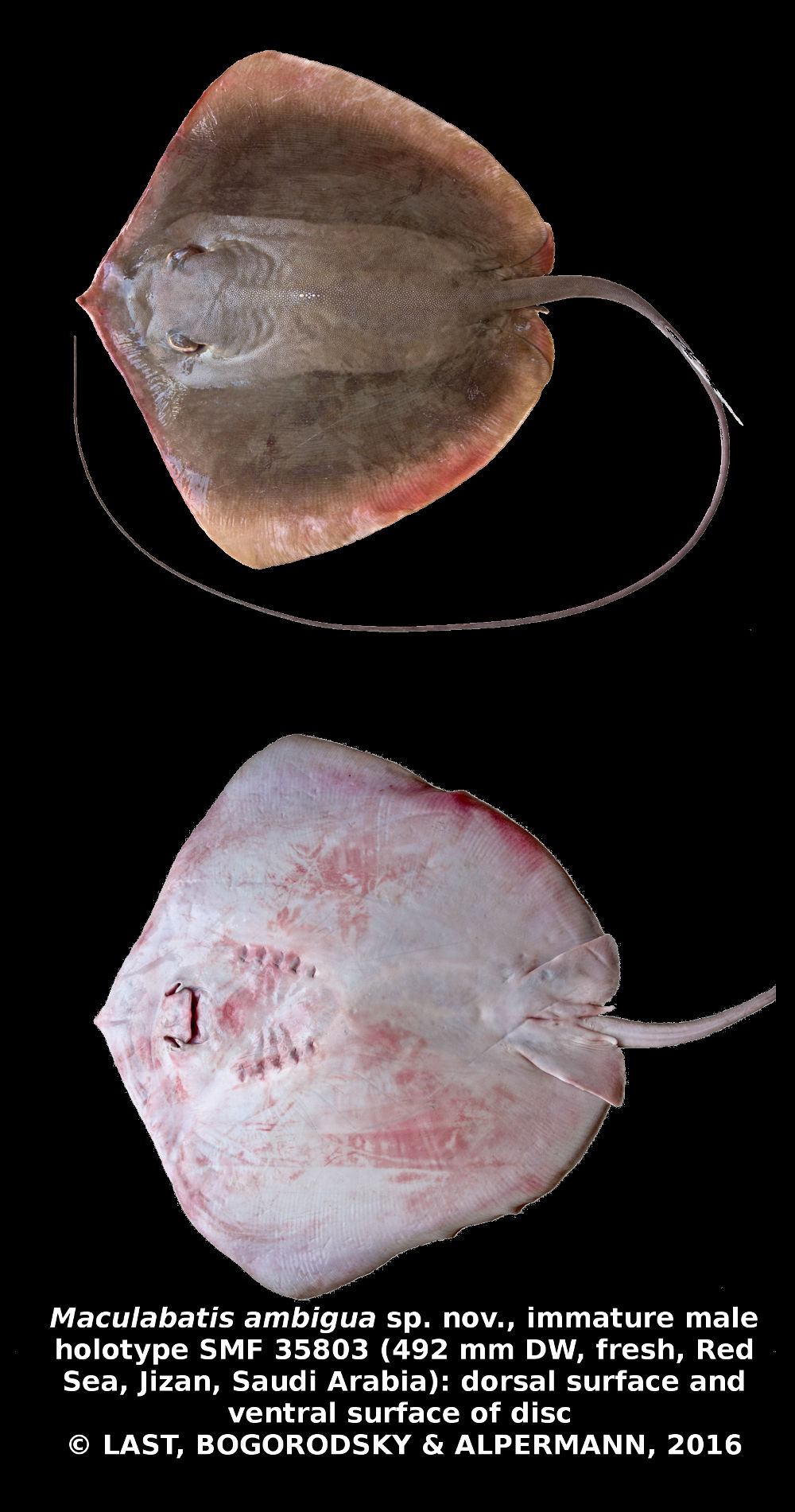Maculabatis ambigua
Last, Bogorodsky & Alpermann, 2016
Classification: Elasmobranchii Myliobatiformes Dasyatidae
Reference of the original description
Maculabatis ambigua sp. nov., a new whipray (Myliobatiformes: Dasyatidae) from the Western Indian Ocean. Zootaxa, 4154(1), 66–78
Maculabatis ambigua sp. nov., a new whipray (Myliobatiformes: Dasyatidae) from the Western Indian Ocean. Zootaxa, 4154(1), 66–78
Synonyms / new combinations and misspellings
Maculabatis cf. ambigua
Maculabatis cf. ambigua
Types
Maculabatis ambigua
Holotype: SMF: 35803; Paratype: CSIRO: H 7993-01 (KAU13-654); CSIRO: H 7994-01 (KAU14-228); CSIRO: H 7995-01 (KAU14-436); KAUMM: 018 (KAU12-552); KAUMM: 19; KAUMM: 048 (KAU12-765); KAUMM: 389 (KAU13-656); KAUMM: 390 (KAU14-397); SMF: 34957 (KAU12-717 & KAU12-718), 2 specimens: ; SMF: 35802 (KAU14-275); SMF: 35804 (KAU14-229);
Maculabatis ambigua
Holotype: SMF: 35803; Paratype: CSIRO: H 7993-01 (KAU13-654); CSIRO: H 7994-01 (KAU14-228); CSIRO: H 7995-01 (KAU14-436); KAUMM: 018 (KAU12-552); KAUMM: 19; KAUMM: 048 (KAU12-765); KAUMM: 389 (KAU13-656); KAUMM: 390 (KAU14-397); SMF: 34957 (KAU12-717 & KAU12-718), 2 specimens: ; SMF: 35802 (KAU14-275); SMF: 35804 (KAU14-229);
Description :
Citation: Maculabatis ambigua Last, Bogorodsky & Alpermann, 2016: In: Database of modern sharks, rays and chimaeras, www.shark-references.com, World Wide Web electronic publication, Version 12/2025
Please send your images of "Maculabatis ambigua" to info@shark-references.com

Maculabatis ambigua sp. nov, immature male holotype SMF 35803 (492 mm DW, fresh, Red Sea, Jizan, Saudi Arabia): dorsal surface and ventral surface of disc © Last, BOGORODSKY & ALPERMANN, 2016

Maculabatis ambigua sp. nov, immature male holotype SMF 35803 (492 mm DW, fresh, Red Sea, Jizan, Saudi Arabia): dorsal surface and ventral surface of disc © Last, BOGORODSKY & ALPERMANN, 2016
Common names
 Baraka’s Whipray
Baraka’s Whipray
 Baraka’s Whipray
Baraka’s Whipray
Short Description
Original diagnosis after LAST, BOGORODSKY & ALPERMANN, 2016 [24370]: A species of the genus Maculabatis distinguished by the following combination of features: disc rhomboidal with its axis of greatest width well forward, snout tip to maximum disc width 37% (35–39%) DW; preorbital snout short with small apical lobe, rather obtuse, snout angle 121–127°; pectoral-fin apices narrowly rounded, angle 86–92°; orbits moderately small, protruding slightly; mouth relatively narrow, width 6.2–7.0% DW; pelvic fins small, length 17–19% DW, width across base 13–14% DW; preoral snout length 2.8–3.1 times internasal width, 19–21% DW, interorbital distance 2.0–2.2 times orbit length, prenasal length 2.2–2.4 times internasal width; tail behind caudal sting subcircular with longitudinal ventral groove; tail weakly depressed posteriorly with longitudinal lateral ridge on each side in subadults; one enlarged, seed-shaped, suprascapular thorn usually followed by up to five much smaller primary denticles in adults (suprascapular thorn may be preceded by a few much smaller primary denticles in early juveniles); band of secondary denticles suboval (in subadults), very broad (its width across scapulocoracoid much narrower than its width at spiracles), with sharply-defined lateral margins, broad and semi-truncate near tail base; band fully developed and covering entire dorsal surface of tail by 49 cm DW; dorsal surface mainly uniformly brownish, disc margin paler brown dorsally; ventral disc uniformly whitish, not obviously black edged; in subadults, darker dorsal surface of tail sharply demarcated from slightly paler ventral surface (median furrow dark and contrasted with skin adjacent); in juveniles, dorsal post-sting tail with conspicuous, alternating, black-and-white saddles that persist nearly to tail tip, ventral tail uniformly greyish; pectoral-fin radials 130–135; total vertebral count (excluding first synarcual centra) 108–116, monospondylous centra 44–46, pre-sting diplospondylous centra 64–67.
Original diagnosis after LAST, BOGORODSKY & ALPERMANN, 2016 [24370]: A species of the genus Maculabatis distinguished by the following combination of features: disc rhomboidal with its axis of greatest width well forward, snout tip to maximum disc width 37% (35–39%) DW; preorbital snout short with small apical lobe, rather obtuse, snout angle 121–127°; pectoral-fin apices narrowly rounded, angle 86–92°; orbits moderately small, protruding slightly; mouth relatively narrow, width 6.2–7.0% DW; pelvic fins small, length 17–19% DW, width across base 13–14% DW; preoral snout length 2.8–3.1 times internasal width, 19–21% DW, interorbital distance 2.0–2.2 times orbit length, prenasal length 2.2–2.4 times internasal width; tail behind caudal sting subcircular with longitudinal ventral groove; tail weakly depressed posteriorly with longitudinal lateral ridge on each side in subadults; one enlarged, seed-shaped, suprascapular thorn usually followed by up to five much smaller primary denticles in adults (suprascapular thorn may be preceded by a few much smaller primary denticles in early juveniles); band of secondary denticles suboval (in subadults), very broad (its width across scapulocoracoid much narrower than its width at spiracles), with sharply-defined lateral margins, broad and semi-truncate near tail base; band fully developed and covering entire dorsal surface of tail by 49 cm DW; dorsal surface mainly uniformly brownish, disc margin paler brown dorsally; ventral disc uniformly whitish, not obviously black edged; in subadults, darker dorsal surface of tail sharply demarcated from slightly paler ventral surface (median furrow dark and contrasted with skin adjacent); in juveniles, dorsal post-sting tail with conspicuous, alternating, black-and-white saddles that persist nearly to tail tip, ventral tail uniformly greyish; pectoral-fin radials 130–135; total vertebral count (excluding first synarcual centra) 108–116, monospondylous centra 44–46, pre-sting diplospondylous centra 64–67.
Distribution
Collected at the Mkokotoni market, Zanzibar (Tanzania) and in the Red Sea off Jizan, southern Saudi Arabia [24370] Source: www.gbif.org
Collected at the Mkokotoni market, Zanzibar (Tanzania) and in the Red Sea off Jizan, southern Saudi Arabia [24370] Source: www.gbif.org
Size / Weight / Age
Medium-sized whipray with largest known specimen, female ~840 mm DW. Birth size probably slightly less than 200 mm DW [24370]
Medium-sized whipray with largest known specimen, female ~840 mm DW. Birth size probably slightly less than 200 mm DW [24370]
Dentition
Teeth of paratype (KAUMM 019) small, subequal in size in upper and lower jaws; rhombic with flattened crowns in upper jaw, smaller with ridged crowns in lower jaw. Tooth rows (paratype KAUMM 019) ~36 in upper jaw (holotype not dissected) [24370]
Teeth of paratype (KAUMM 019) small, subequal in size in upper and lower jaws; rhombic with flattened crowns in upper jaw, smaller with ridged crowns in lower jaw. Tooth rows (paratype KAUMM 019) ~36 in upper jaw (holotype not dissected) [24370]
Remarks
shark-references Species-ID=14689;
shark-references Species-ID=14689;

















